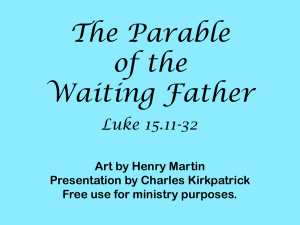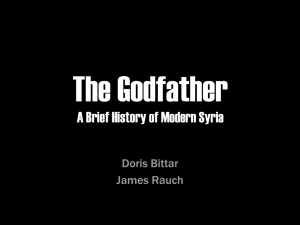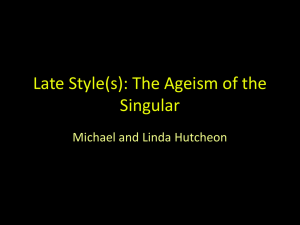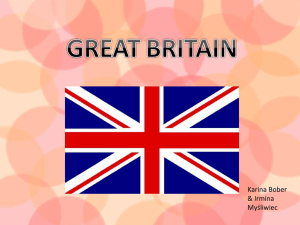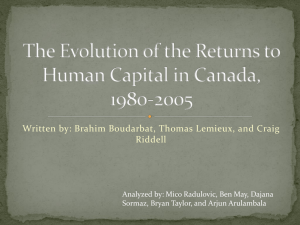Acoustics and obsolescence in Scottish Gaelic stop
advertisement
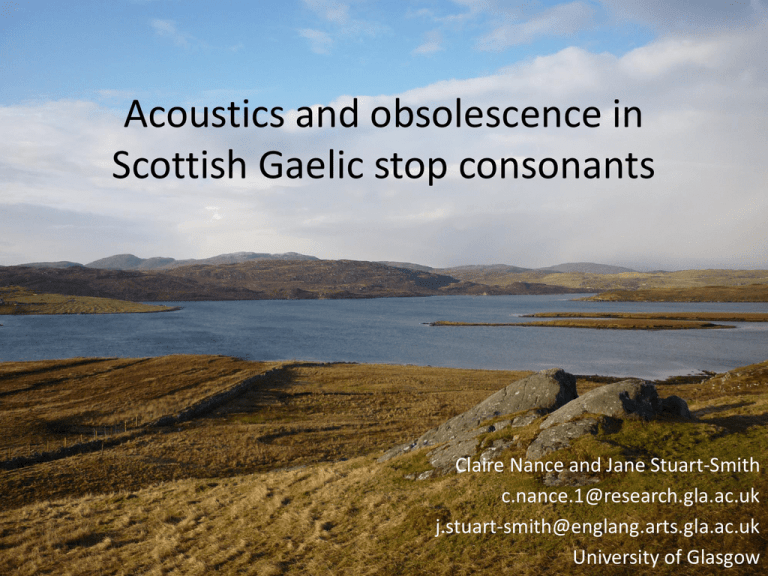
Acoustics and obsolescence in Scottish Gaelic stop consonants Claire Nance and Jane Stuart-Smith c.nance.1@research.gla.ac.uk j.stuart-smith@englang.arts.gla.ac.uk University of Glasgow Overview • • • • • • • (Very brief) sociolinguistic introduction Stop consonants in Gaelic Research questions Methods Results Ongoing work Conclusion Sociolinguistic context • c.60,000 ‘speakers’ but numbers reducing • Revitalization ongoing • MacKinnon 2010 • Framework here: obsolescence (Anderson 1982, Dorian 1981, Jones 1998, Babel 2009), and contact with English (Thomason 2007) Lewis context Lewis/ Leòdhas • Densest concentration (MacKinnon 2010) Stop consonants in Gaelic • Word initial /ph th kh/ and /p t k/ • Word medial and word final /hp ht hk/ and /p t k/ (Ladefoged et al. 1998) • (Also palatalised vs. velarised distinction) • ‘Aspirating language’ (Jessen and Ringen 2002), [spread glottis] (Kingston, forthcoming 2010) Examples boc ‘male goat’ bog ‘soft’ Examples smoc ‘smoke’ snog ‘nice’ Research questions • What are the phonetic correlates of the contrast /ph th kh/ and /p t k/ in modern Gaelic? • Is this system changing as the language undergoes obsolescence? Methods • • • • • Native speakers of Lewis Gaelic 3 older generation, 3 younger Recording conditions Word list data Non-parametric statistical tests Durational measures • Segmenting on the waveform in Praat • What is pre-aspiration? (Ní Chasaide 1985) Vowel Modal voice a Preaspiration BV Noise c a Adapted Zero Crossing Rate (Gordeeva and Scobbie 2010) • Ongoing work: Adapted ZCR in collaboration with Olga Gordeeva – still awaiting statistical analysis • Compares and quantifies pre- and postaspiration using by counting zero crossings on a band-pass filtered sound file • Interested in noise from the glottis Results: contrast /kh/, /k/ càl [kʰɑ:ɫ ̪ ] cabbage, gal [kaɫ ̪ ] steam /kʰ/ n = 306 /k/ vot vowel 0 50 100 150 200 250 300 Results: contrast /hk/, /k/ aca ‘at them’ [aʰkə], baga ‘bag’ [pakə] /ʰk/ vowel start Stop burst n = 54 closure preasp modv vot -300 -250 /k/ -200 -150 -100 -50 0 50 Differences: word initial • YP VOT longer • Also proportionally n = 306 n = 306 older older vot % vot vowel % vowel younger -100 younger 100 300 0% 50% 100% Results medial and final /hk/, /k/ • YP Shorter pre-aspiration • Pre-aspiration different n = 144 Stop closure Results medial and final /hk/, /k/ • YP Shorter pre-aspiration • Pre-aspiration different % modal voice % breathy voice % noise Older n = 144 Younger 0% 20% 40% 60% 80% 100% Examples: can you hear the difference? Older speaker: boc ‘male goat’ Younger speaker: boc ‘male goat’ Older speaker: smoc ‘smoke’ Younger speaker: smoc ‘smoke’ Adapted Zero Crossing Rate: Initial /kh/ càl [kʰɑ:ɫ ̪ ], /k/ gal [kaɫ ̪ ] 4500 younger /kh/ older /kh/ younger /k/ older /k/ 4000 3500 3000 2500 2000 1500 1000 n = 108 500 0 zcr_1 zcr_2 zcr_3 zcr_4 zcr_5 3500 Word medial /hk/, /k/ aca ‘at them’ [aʰkə], baga ‘bag’ [pakə] 3000 2500 2000 1500 younger /hk/ 1000 older /hk/ 500 n = 72 younger /k/ older /k/ 0 zcr_1 zcr_2 zcr_3 zcr_4 zcr_5 Word final /hk/, /k/ boc ‘male goat’ [pɔʰk], bog ‘soft’ [pok] 3500 3000 2500 2000 1500 younger /hk/ 1000 older /hk/ 500 n = 108 younger /k/ older /k/ 0 zcr_1 zcr_2 zcr_3 zcr_4 zcr_5 Conclusion • Apparent time differences • Comparison to Ladefoged et al. (1998) Real time change? Noise Younger n = 190 Older VOT Ladefoged -150 -100 -50 0 50 Conclusion • Gradient phonetic shift (Babel 2009) • Obsolescence / contact / ‘normal’ change? • Lexical attrition References • • • • • • • • • • • • Anderson, R., 1982. Determining the linguistic attributes of language attrition. In Lambert and Freed, eds., The loss of language skills. Rowley: Newbury House Publishers Babel, M., 2009. The phonetic and phonological effects of obsolescence in Northern Paiute. In J. Stanford and D. Preston, eds., Variation in indigenous minority languages. Amsterdam: John Benjamins Dorian, N., 1981. Language death: the life cycle of a Scottish Gaelic dialect. Philadelphia: University of Pennsylvania Press Gordeeva, O., and Scobbie, J., 2010. Preaspiration as a correlate of word-final voice in Scottish English fricatives. In S. Fuchs, M. Toda, M. Zygis, eds., Turbulent sounds: an interdisciplinary guide. Berlin: Mouton de Gruyter Jessen, M., and Ringen, C., 2002. Laryngeal features in German. Phonology, 19:2, pp. 189-218 Jones, Mari, 1998. Obsolescence and revitalization: linguistic change in two sociolinguistically contrasting Welsh communities. Oxford: Blackwell Kingston, J., Voice. Forthcoming in Phonology Ladefoged, P., and Ladefoged, J., Turk, A., Hind, K., Skilton, St. J., 1998. Phonetic structures of Scottish Gaelic. Journal of the International Phonetic Association 28, pp. 1-41 MacKinnon, K., 2010. Scottish Gaelic today: social history and contemporary status. In M. Ball and N. Müller, eds., The Celtic languages. 2nd. ed. London: Routledge Ní Chasaide, A., 1985. Pre-aspiration in phonological stop contrasts. Unpublished PhD thesis, University of Bangor Silverman, D., 2003. On the rarity of pre-aspirated stops. Journal of linguistics, 39:3. pp. 575-598 Thomason, S., 2007. Language contact: an introduction. 4th ed. Edinburgh: Edinburgh University Press Tapadh Leibh / Thank you • My supervisor and co-author: Jane Stuart-Smith • Collaborator: Olga Gordeeva, Acapela Group ogordeeva@gmail.com • My informants: Susan Bell, Christeen Combe, Aoghas MacCoinnich, Sarah MacKinnon, Colm Macqueen and all those who wished to remain anonymous • Research funded by a Kelvin-Smith Scholarship, University of Glasgow
